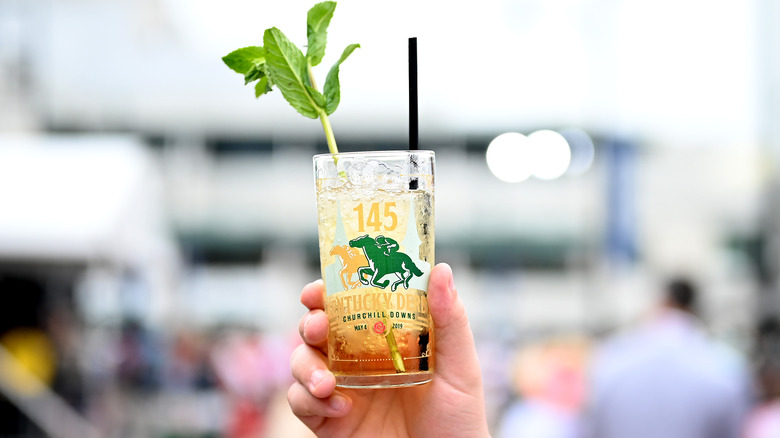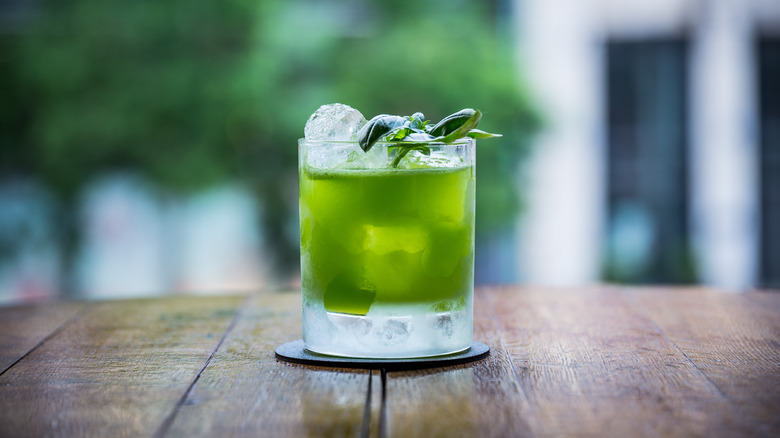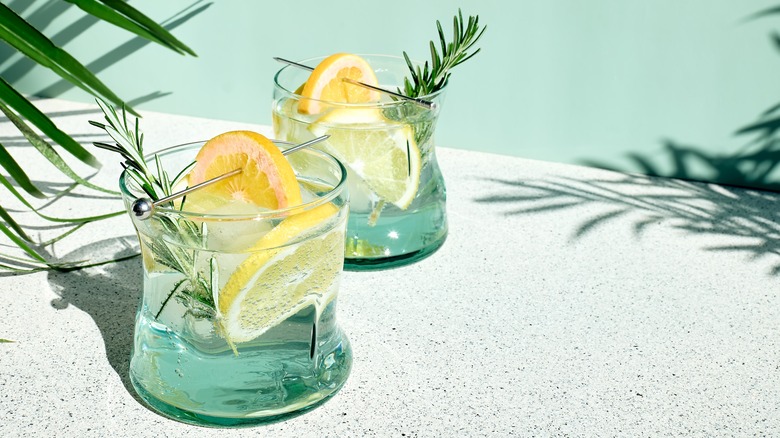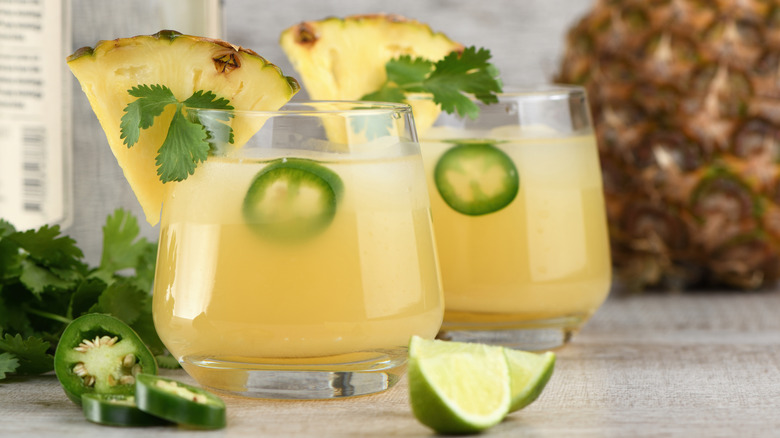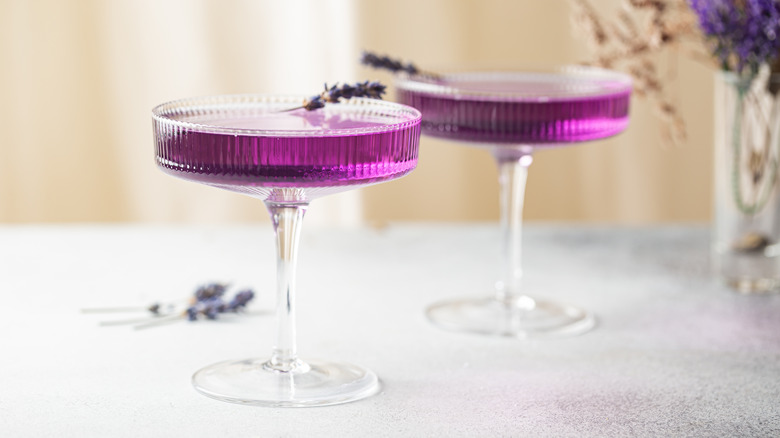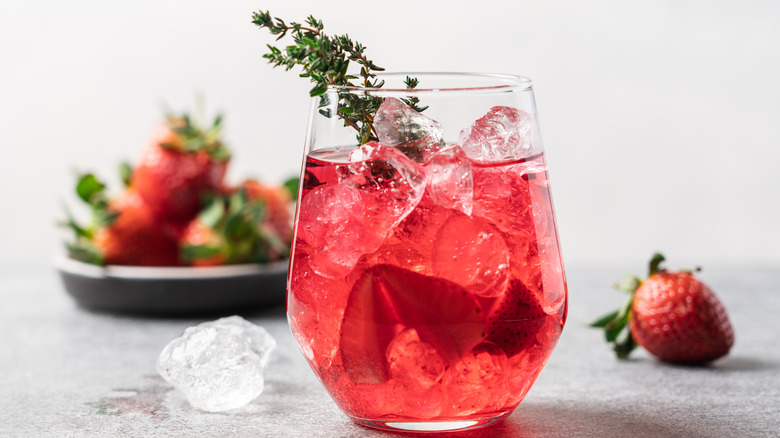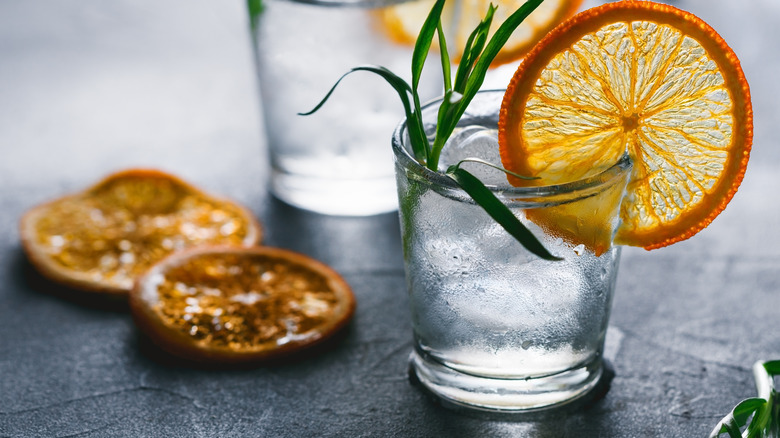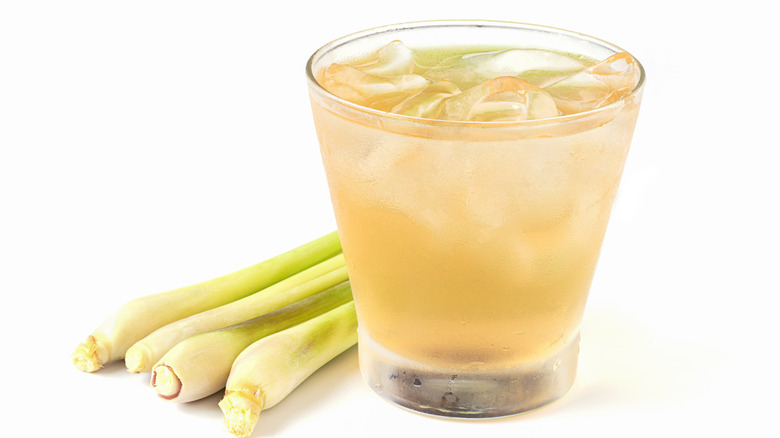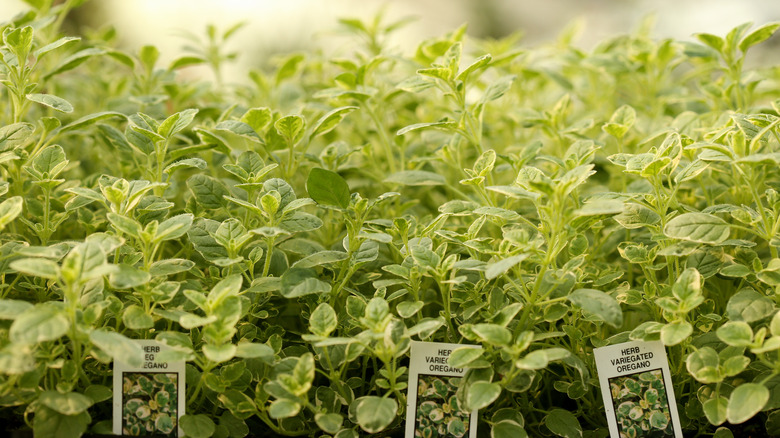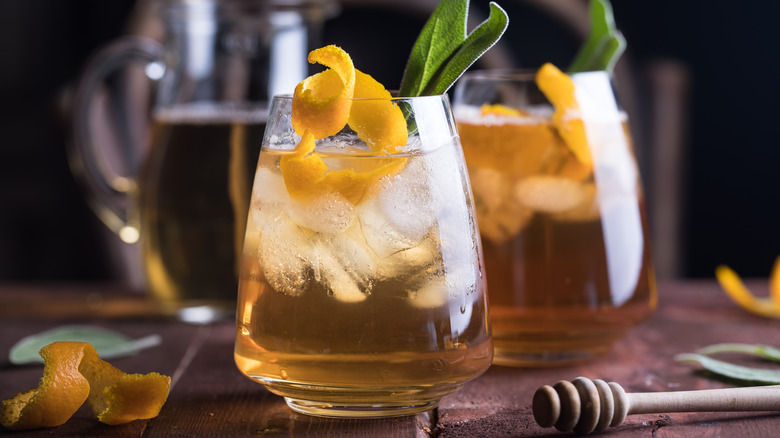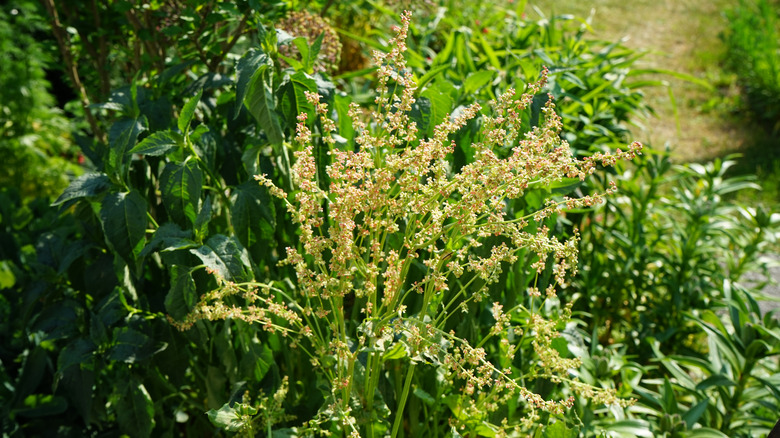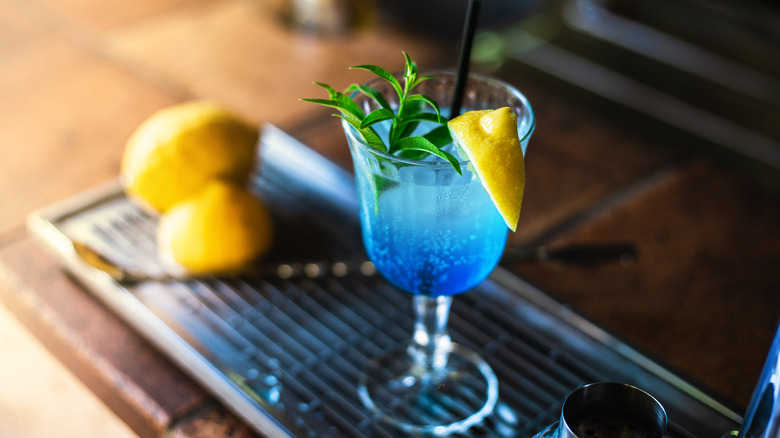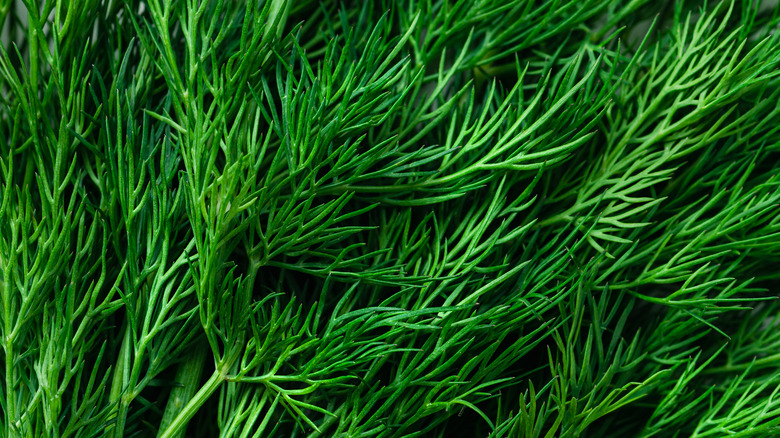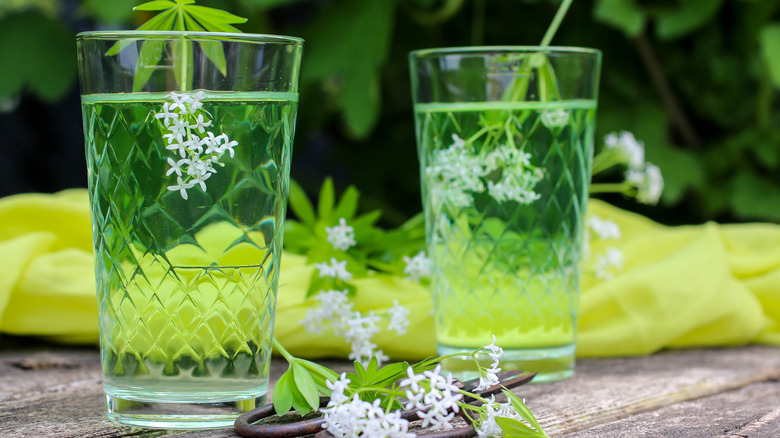The Best Herbs To Add To Your Cocktails
Alcohol is a social lubricant that has helped humans interact with each other for centuries (via The Atlantic). Alcohol is consumed in various forms year-round. For many, summer is a time of holidays, festivals, numerous sun-drenched social interactions, and cracking open cold beers. However, steadily dropping rates of beer sales in the U.S. indicate that Americans are interested in experimenting with a variety of drinks.
Cocktails are often viewed as fun, exciting alternatives to beer. The consumption of cocktails has seen a sustained increase during the summer months (via Statista). However, the sheen of cocktails can sometimes be dulled by the appearance of the same tired drinks over and over again. Another standard margarita or subpar martini may not always excite the senses.
However, sprucing up your evening tipple doesn't always require a complete and expensive revamp of your bar. Instead, herbs, thanks to their aromatic and flavorful properties, offer a quick way of transforming well-known drinks into something that is both exciting and enticing. These small but mighty plants do much to overhaul those classic, tried, tested, and tired cocktails.
Mint
Mint is a classic herb; a refreshing stalwart that adds a cooling sensation to any cocktail. However, not all types of mint are created equal, and with over 600 varieties of mint out there, it can be easy to lose yourself amongst the various strains of leafy greens. To simplify matters, spearmint should be your first port of call for classics such as mojitos and mint juleps. However, interesting varieties of mint, such as orange mint, provide you with an easy opportunity to shake up even the most classic of cocktails.
Peppermint is another subgroup of mint that provides a great option for cocktails. Few mixologists choose to utilize this herb because of its powerful menthol notes (via Reluctant Gourmet). As poetically expressed by famed barman Chris McMillan, "the man who would put peppermint into a mint julep would put scorpions into a baby's bed."
Regardless of your chosen varietal of mint, it's important to smack the herb to release flavor (via VinePair). Leading mixologist Ryan Chetiyawardana recommends against muddling the herb as the resultant damage inflicted on the plant will have the sad effect of giving the cocktail an overwhelmingly bitter aftertaste (via Masterclass). If you're planning on making a large number of cocktails Imbibe Magazine suggests forgoing the leaves altogether and using a simple mint syrup to save on both time and effort.
Basil
Although basil is commonly associated with Mediterranean cooking, it can also be used to boost the flavor of many different cocktails. This herb has an extremely fragrant nature, a fact that has mixologists reaching for the herb time and again (via Cocktail Party). The sweet, citrus aromas that basil emits can instantly upgrade many drinks, even the gin and tonic cocktail (via Serious Eats).
As delightful as inhaling the scent of basil can be, a few mixologists have created recipes that incorporate the basil into delicious cocktails. The gin basil smash, invented in 2008, has captured the hearts and minds of cocktail lovers across the globe (via Moody Mixologist).
This simple cocktail perfectly displays the timeless combination of basil and lemon. The recipe for this cocktail uses actual basil leaves, in contrast with more classic cocktails. As the creator of this cocktail, Jörg Meyer, explains, "We pack a whole handful in the shaker, including the stems, which are important for the color. And the muddling shouldn't be too heavy. Otherwise the color turns too grassy-green and the drink goes mossy" (via Mixology).
Rosemary
Whilst rosemary's needle-like leaves are well suited to the task of flavoring food, finding flecks of the herb in your drink is far from ideal unless you like sipping your cocktail through clenched teeth. However, there are ways of incorporating rosemary's delightfully woody flavor into your cocktails without ending up with a debris-filled drink.
The solution, according to Food & Wine, is to create a rosemary-infused syrup that can be mixed into cocktails and adds both sweetness and the herbal hit of rosemary. Perhaps the best time to utilize rosemary syrup is during the holiday season, as demonstrated by the festive cranberry rosemary spritzer from Tasting Table.
Fortunately, the use of this celebrated herb is not limited to the colder months. Many herbs are seasonal to summer, which is when their usage in bars and restaurants generally increases and rosemary is no exception. According to Market Watch, rosemary is a wonderful and refreshing addition to highballs that help customers stave off the summer heat.
Cilantro
Adding an ingredient that is so divisive that it has been coined the marmite herb is a brave move for any bartender, professional or not. This becomes doubly apparent when one considers the well-documented genetic disparities that may cause some people to experience a soap-like flavor when eating cilantro (via Britannica). However, the herb's aromatic, slightly citrus flavor (on paper, at least) seems to be an ingredient that is well suited to cocktails.
Some mixologists are demonstrating that cilantro's flavors don't just work well in theory, but in practice as well: Nathalie Wenko won the 2022 Italicus Aperitivo challenge with a cocktail that contained her own cilantro essence (via The Spirit Business).
Furthermore, mixologists at Tell Camellia, a bar in Hong Kong that has been featured in Asia's 50 best bars, have successfully used cilantro in a cocktail that also features Brazilian tea (via South China Morning Post).
For those who are not ready to attempt making these highly complex drinks, cilantro can also be added to cocktails such as margaritas. The sour, lime flavor of the margarita goes naturally with the herb, as exemplified by the abundance of cocktails featuring cilantro at this year's margarita wars (via Patch).
Lavender
Lavender is a floral herb that has been used by humans for millennia, often for medicinal purposes (via American Botanical Council). Lavender is now a featured ingredient in many European cuisines (via Masterclass). Lavender has slowly begun to be used by mixologists, many of whom have found it to be surprisingly versatile, as Parker Boase co-founder of the Liquid Lab NYC, explained to Tales of the Cocktail: "Lavender adds a unique floral note that complements a variety of different base spirits and liqueurs. It goes especially well with gin cocktails, as it helps open up the earthy botanical notes of a dry gin."
However, as is the case with other herbs, there are a few things to be wary of when incorporating lavender into your cocktails. The first and foremost of these concerns is whether fresh or dried lavender should be used. As respected industry leader Nicole Lebedevitch advises, "Do you want the earthy, slightly more bitter tones with a whisper of floral aromatics? Then I suggest fresh lavender. Do you want an in-your-face lavender essence with a mild bitterness? Then you probably want dried."
Thyme
Thyme is a highly unique herb. It treads the line between many contrasting flavors and it can consequently help highlight the often-overlooked facets of the ingredients that it is paired with in dishes and drinks (per Los Angeles Times). The incredible flavor and the delicate balancing act it performs are preceded by an unmistakably pungent aroma, making thyme the ideal garnish for cocktails.
Thyme is a powerful herb, thyme can be used in situations where other herbs would falter. According to Southern Living, mixologist Tiffanie Barriere, who is also a member of the prestigious James Beard beverage advisory board, uses thyme to brighten potent dark spirits to make them lighter and more palatable. A more traditional, yet by no means less effective way of using a thyme garnish is to place it amongst lighter, citrus-heavy drinks. The thyme will amplify these tasting notes, as well as other herbaceous ones, ensuring that cocktails (like the thyme-infused wine punch) will carry an incredible amount of flavor.
Tarragon
As herbs go, tarragon is a strange combination of niche and mainstream. While many of us have likely heard of it, it is not used or discussed as much as other herbs like basil and cilantro (via The Spruce Eats). Unfortunately, our seemingly instinctive neglect of this herb is as common behind the bar as it is in the kitchen (via The Cocktail Novice).
Tarragon carries an anise-like flavor and is rich in an organic compound called estragole, which is beneficial for a number of different cocktails. Chief among these is the perennial Spanish crowd-pleaser, sangria. As Evie Negri-Albert, an established mixologist, explains to Huffington Post, though sangria is often viewed as a summer drink, the inclusion of tarragon can transform the drink into something that is more suited to the winter months.
Negri-Albert utilizes a citrus, white wine, and tarragon-rich blend to transform the famous drink into a warmer, more robust version of the original that perfectly matches the seasonal changes of winter.
Lemongrass
Fibrous shoots of lemongrass are a staple in Thai cuisine; they're frequently used alongside other powerful ingredients to make flavor-packed dishes such as curry (per Masterclass). The delicate yet durable flavors of lemongrass make the herb suitable for many cooking processes, and consequently, the herb is used in several different cuisines across the world (via Seasoned Pioneers).
Keen to put this flavor and versatility to good use, mixologists have increasingly incorporated lemongrass into their cocktails. Santosh Kukreti, head mixologist at the newly reopened Slink & Bardot in Mumbai has utilized lemongrass to create a cocktail that is reminiscent of jackfruit (per Condé Nast Traveler). Meanwhile, mixologists at MINA brasserie in Dubai have used the herbs to add a zing to the "Starry Night" cocktail, an extremely ambitious drink that recreates Van Gogh's famous painting by the same name in a glass (via The Times of India).
Admittedly, both these establishments are creating very complex drinks which would likely take some practice, and perhaps a little luck to execute at home. Yet, a cocktail need not be complicated to benefit from the addition of lemongrass. This gin-laced sun tea by the Tasting Table test kitchen is an easy, hands-off lemongrass cocktail that will prove both delightfully refreshing and startlingly tasty.
Oregano
Oregano is a traditional condiment that is featured in many classic cocktails: This is not because mixologists have long been in the habit of adding sprigs to drinks, but because the herb is frequently used to infuse vermouth, a staple component of most cocktail cabinets (via Mixing Ingredients). As such, tasting notes of classic pours such as negronis and martinis frequently contain the peppery undertones associated with the herb.
Maybe Sammy, voted Australasia's finest bar in 2021 and the 22nd best bar globally, is renowned for its world-class beverages. According to Time Out, the bar has been diversifying its income stream by selling premixed bottles of some cocktail classics, all with a touch of that unique, Maybe Sammy flair. These bottled cocktails include varieties such as the Italian dirty martini, which attains its flourish through the inclusion of oregano-infused olive brine (via Maybe Sammy).
For the budding mixologist looking to add a twist of their own, a simple garnish of an oregano sprig can bring out the flavor of any vermouth-based cocktail. Boulevardiers and negronis both stand to benefit greatly from the addition of oregano. As Tasting Table suggests, for an extra smoky kick, try charring the herb beforehand.
Sage
Both sage and bitters were initially used for their medicinal properties: The prior forms a vital part of ceremonies and medicinal practices in Indigenous North American societies, due to its status as one of the four sacred medicines (per Under One Sky Friendship Center). Bitters are a type of botanical-infused alcohol that was initially sold as medicine (via Smithsonian Magazine).
However, sage is not prominently featured in bars due to its strong and robust flavor (via Masterclass). Yet, the herb has found a new lease of drink-based life thanks to its incorporation in cordials. As reported by The Guardian, these so-called fancy cordials have not only come to dominate the mocktail market, but they have also begun to increasingly feature in simple cocktail recipes.
The pre-mixed nature of these cordials, such as Urban Cordial's strawberry and sage product, allows customers to utilize the flavor of potent herbs like sage whilst minimizing the risk of overpowering their drink with flavor.
Sorrel
Statistics show that a growing number of consumers are turning their backs on alcohol for a variety of reasons (via The Conversation). Consequently, the once sparse list of low-alcohol options available in both supermarkets and pubs have swelled to include a range of non-alcoholic craft beers and spirits.
Sorrel is a bitter and generally underutilized herb that is commonly used in non-alcoholic drinks. Rex at the royal is a southern-style restaurant from Philadelphia that has demonstrated sorrel's ability to flavor non-alcoholic drinks by including it in its popular mocktail entitled "Sorrel Loser" (via Philadelphia).
This is not to say that sorrel cannot feature in alcoholic cocktails. Rather, the herb is rapidly forming an integral part of many mixologists' regular repertoire, as explained by Max Venning, co-owner of Three Sheets, one of the best bars in the world: "We're seeing a lot more recipes with savoury and saline flavour profiles. Ingredients like sorrel, lovage, beetroot, coriander and pickle juices are now an established part of the bartender's arsenal" (via The Financial Times).
Lemon Verbena
Lemon verbena is a herb that was once only found in parts of South America. It has gradually become prominent throughout the world, thanks in part to its sturdy nature and ability to flourish in warm climates (via Speciality Produce). This sprightly herb has found unlikely fame since Buckingham Palace launched its own small-batch dry gin infused with lemon verbena picked from the palace's own gardens (via Royal Collection Shop).
However, if you'd like to forgo infused spirits and incorporate the fresh herb directly into a spirit or drink of your own choice, you are spoilt for choice. That is because the herb's citrusy zing can liven up drinks ranging from gimlets to daiquiris. Lemon verbena has even played a part in the creation of a game-changing cosmopolitan (via KCRW).
Using lemon verbena in a cocktail can be as easy as making simple syrup or incorporating a few leaves into your shaker or glass. Either method will lift your drink's entire flavor profile. Or, if that sounds like too much work, let the professionals do what they do best and try some premixed cocktails such as Kyla's Lemon Verbena Drop.
Dill
Dill has long been pigeonholed as the herb that pairs well with fish, and for good reason: This herb has a delicate flavor that can accentuate, rather than dominate nearly all types of fish (via Masterclass). Scandinavian cuisine has championed the celebration of subtle fish dishes, as typified by past seafood menus from the esteemed restaurant, Noma (via Anders & Kaitlin).
Unsurprisingly, this very same cuisine champions dill in surprising ways. The Nordic countries produce Aquavit, a traditional spirit often flavored with dill seed that is an important part of Scandinavian culture (via Nordic Spirits). Cocktails made from this spirit often taste dominantly of dill, a fact which has meant that many mixologists tend to use it quite sparingly (via Cocktails of Copenhagen).
Short of adding aquavit to your own spirit collection, incorporating dill into your cocktails can prove tricky. The best bet is to pair the herb with gin-based cocktails, generally as a garnish. If you are feeling brave, double down by copying world-renowned mixologist Gareth Evans and add it to your shaker to impart all of the herb's unique flavor (via Definitive Drinking Guide).
Woodruff
Woodruff may not be quite as well known as other herbs, which is surprising given its ability to grow well across the United States (via The Manual). However, in Britain, the herb has gained some renown in mixologist circles thanks to Bruno Vilas, an award-winning bartender at the Michelin-starred English restaurant, Forest Side (via The Forest Side).
Forest Side, which is renowned for using local produce, proved the perfect setting for Vilas to experiment with woodruff. Armed with bittersweet woodruff foraged from the surrounding country, Vilas created an exceptional riff on a negroni and earned himself Seasonal Serve of The Year at the very first U.K. Bar Menu of the Year Awards.
His success opened the door for other mixologists, such as Stefan Huebner, to delight in the herb. Huebner uses the herb to make a white wine punch called maibowle. This unique cocktail, which can include lashings of the celebrated German wine, Riesling, also includes champagne and plenty of woodruff. This cocktail incorporates woodruff both within the cocktail and as a garnish atop the cocktail, which allows the hay-like aromas of this herb to bring the punch to life.

